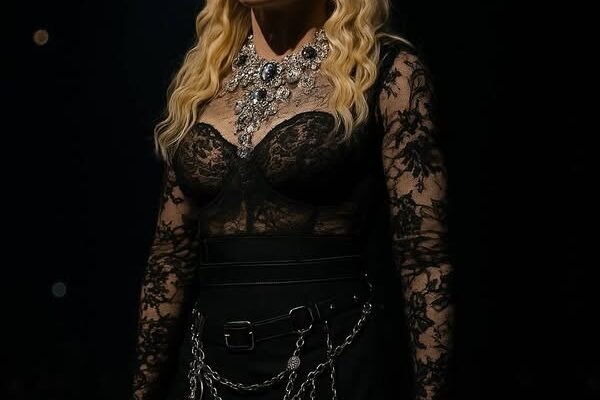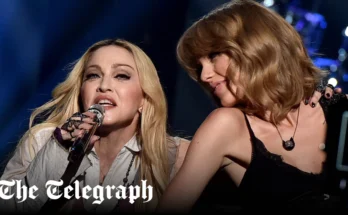When Madonna’s “Into the Groove” burst onto the music scene in 1985, it wasn’t just a new hit single; it was a cultural phenomenon. Embedded in the soundtrack of the film Desperately Seeking Susan, the track didn’t just accompany a movie—it ignited it. Suddenly, movie scenes became makeshift dance floors, and Madonna’s already-ascendant career exploded into the stratosphere. With this infectious, beat-driven anthem, she didn’t just ask people to dance—she made them need to.
And in the United Kingdom, “Into the Groove” did more than top the charts—it became her first UK No. 1 single, and, remarkably, remains her best-selling single in the country to this day. It’s a testament to the song’s staying power that four decades later, it continues to move generations—on dance floors, in pop culture, and through endless reinvention.
The Birth of a Club Anthem
Madonna wrote “Into the Groove” with then-boyfriend Stephen Bray, intending it initially for another artist. But as the song evolved, it became clear that it had to be hers. There’s a raw, unfiltered energy pulsing through the track—synth-pop at its most addictive, paired with an unmistakable vocal style that screams confidence, attitude, and an irresistible invitation: “Only when I’m dancing can I feel this free.”
Released as part of the soundtrack for Desperately Seeking Susan, in which Madonna played a quirky, street-smart free spirit, “Into the Groove” played a dual role. It elevated the film, making even mundane scenes pulse with kinetic energy, and at the same time, established Madonna not just as a singer or a dancer, but as a pop icon who could control the screen just as well as the stage.
It was never formally released as a commercial single in the U.S. (it was a B-side to “Angel”), yet it still topped Billboard’s Dance Club Songs chart and became a club staple. But in the UK, it was released as a stand-alone single and quickly ascended to No. 1, where it stayed for four consecutive weeks.
Why “Into the Groove” Worked—And Still Does
One word: accessibility. “Into the Groove” is not a song that demands analysis or pretension. It’s pure energy, joy, and abandon. It opens with a simple yet catchy synth riff, builds with a disco-tinged beat, and then explodes into a chorus designed to make people move. Lyrically, it’s an ode to the freedom and joy found in dance—a universal experience that transcends time and place.
Madonna’s vocals are playful, flirtatious, and commanding all at once. She sounds like someone who’s found her element and wants to bring you into it. There’s no hidden agenda here—just a pulsing beat and the invitation to “get into the groove.”
It’s also a masterclass in production. Bray’s layered synths, drum machines, and rhythmic bass create a sonic texture that’s rich and danceable, but never overwhelming. Even today, DJs and remixers cite “Into the Groove” as a perfect pop-dance template—simple, effective, and electric.
A Cultural Touchstone
The mid-1980s were Madonna’s crucible—Like a Virgin, Material Girl, and Holiday were already radio fixtures. But “Into the Groove” felt different. It was rooted less in provocation and more in participation. This was Madonna the tastemaker, not the headline-maker.
The music video—composed of clips from Desperately Seeking Susan—contributed to Madonna’s growing image as a downtown fashion icon, blending punk sensibility with club-kid glam. The song and the film reinforced each other: the movie gave Madonna’s character visual life, and the song gave the film a heartbeat.
In clubs across the world, from New York to London to Tokyo, “Into the Groove” wasn’t just played—it was experienced. It created a kind of communal euphoria, something only the greatest pop songs can manage.
UK Success: A Defining Moment
It’s no small thing to say that “Into the Groove” is Madonna’s best-selling single in the UK. For an artist with such a legendary discography—multiple chart-toppers including “Vogue”, “Like a Prayer”, and “Hung Up”—this early hit still reigns supreme. It sold over 850,000 physical copies in the UK alone and was certified platinum by the BPI.
Its success cemented Madonna’s dominance in the British market and set the stage for her to become one of the best-selling female artists in UK chart history. It also set a precedent: from this point forward, any Madonna release was an event.
Legacy and Reinvention
“Into the Groove” has been remixed, sampled, and covered countless times. It’s been featured in TV shows, commercials, and films. In her live shows, Madonna frequently revives it, often with modern twists—like a mashup with “Vogue” or an EDM reinterpretation.
It remains a favorite among fans and critics alike. Rolling Stone, Pitchfork, and NME have all included it on “best of the 80s” and “greatest dance tracks” lists. Its legacy isn’t just that it was a hit—it’s that it changed how people engaged with pop music. It was an early example of the synergy between music and film, between fashion and sound, and between artist and audience.
Conclusion: Still Into the Groove
Nearly 40 years after its release, “Into the Groove” continues to do what it did best—make people dance. It is a pop time capsule, yet timeless in its appeal. It represents the moment Madonna went from pop star to pop legend—a moment where art, attitude, and beat came together perfectly.
In the pantheon of Madonna hits, some may be more controversial (“Like a Prayer”), more musically ambitious (“Frozen”), or more globally dominant (“Hung Up”), but few are as instantly exhilarating as “Into the Groove.”
It’s not just Madonna’s first UK No. 1. It’s a declaration: the groove is where freedom lives—and Madonna, forever the queen of reinvention, invited the whole world to move with her.



